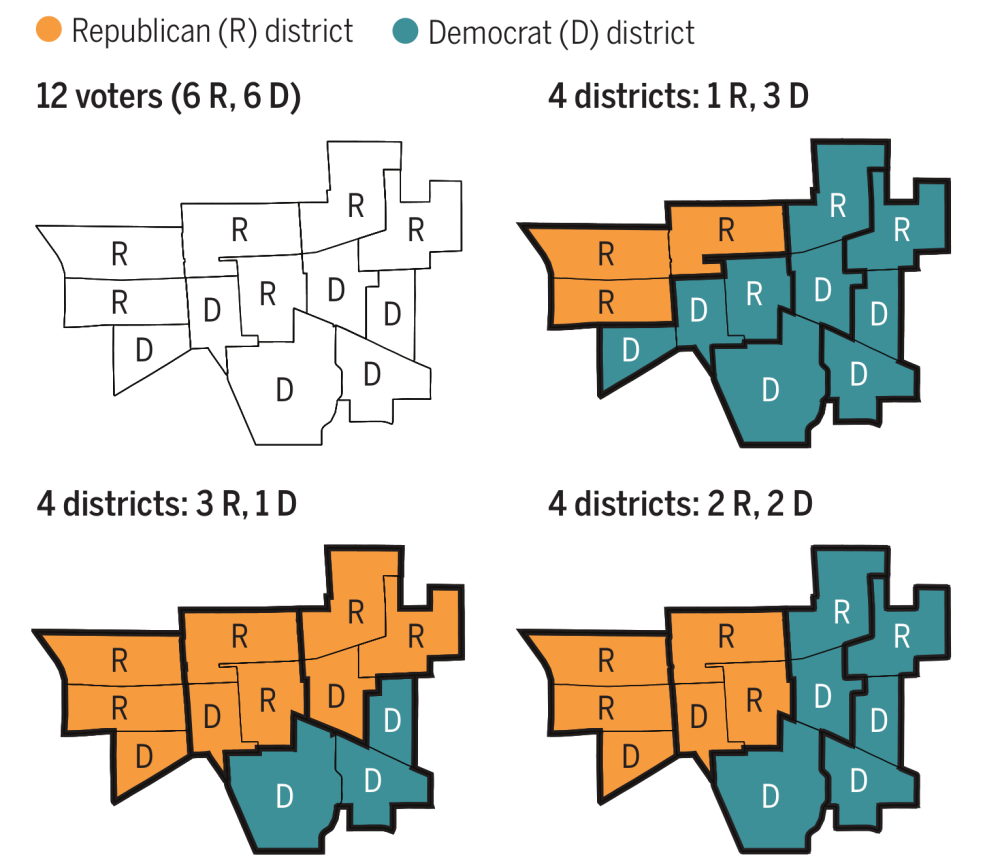Gerrymandering is one of the most insidious methods out there of influencing our political process. By legally changing the way votes are collected and counted, the outcomes can be influenced — even fixed in advance for years. The solution may be an AI system that draws voting districts with an impartial hand.
Ordinarily, districts that correspond to electoral votes within a state are drawn essentially by hand, and partisan operatives on both sides of the aisle have used the process to create distorted shapes that exclude hostile voters and lock in their own. It’s so effective that it’s become commonplace — so much so there’s even a font made out of gerrymandered districts shaped like letters.
What can be done? Automate it — at least partially, say Wendy Tam Cho and Bruce Cain in the latest issue of Science, which has a special section dedicated to “democracy.” Cho, who teaches at the University of Illinois at Urbana-Champaign, has been pursuing computational redistricting for years, and just last year was an expert witness in an ACLU lawsuit that ended up overturning Ohio’s gerrymandered districts as unconstitutional.
In an essay explaining their work, they summarizes the approach thusly:
The way forward is for people to work collaboratively with machines to produce results not otherwise possible. To do this, we must capitalize on the strengths and minimize the weaknesses of both artificial intelligence (AI) and human intelligence.
Machines enhance and inform intelligent decision-making by helping us navigate the unfathomably large and complex informational landscape. Left to their own devices, humans have shown themselves to be unable to resist the temptation to chart biased paths through that terrain.
There are effectively an infinite number of ways you could divide a state into a given number of shapes, so the AI agent must be primed with criteria that limit those shapes. For instance, perhaps a state doesn’t want its districts to be any larger than 150 square miles. But then they must also account for shape — you don’t want a snakelike district slithering around the margins of others (as indeed occurs often in gerrymandered areas), or one to be enveloped by another. And then there are the innumerable historical, geographical, and demographic considerations.

This illustration from Cho and Cain’s article shows a simplified version of a districting problem showing how partisan districts can be created depending on who’s drawing them. (Image credits: Cho/Cain/Science)
In other words, while the rationale for drawing must be set by people, it is machines that must perform “the meticulous exploration of the astronomical number of ways in which a state can be partitioned.”
Exactly how this would work would be up to the individual state, which will have its own rules and authorities as to how district maps are drawn. You see the problem immediately: We have entered politics, another complex landscape through which humans tend to “chart biased paths.”
Speaking to TechCrunch, Cho emphasized that although automation has potential benefits for nearly every state process, “transparency within that process is essential for developing and maintaining public trust and minimizing the possibilities and perceptions of bias.”
Some states have already adopted something like this, she pointed out: North Carolina ended up choosing randomly from 1,000 computer-drawn maps. So there is certainly a precedent. But enabling widespread use means creating widespread trust — something that’s in mighty short supply these days.
Mixing tech and politics has seldom proved easy, partly because of the invincible ignorance of our elected officials, and partly a justified distrust of systems that are difficult for the average citizen to understand and, if necessary, correct.
“The details of these models are intricate and require a fair amount of knowledge in statistics, mathematics, and computer science but also an equally deep understanding of our how our political institutions and the law work,” Cho said. “At the same time, while understanding all the details is daunting, I am not sure this level of understanding by the general public or politicians is necessary. The public generally believes in the science behind vaccines, DNA tests, and flying aircraft without understanding the technical details.”
Indeed, few people worry whether the wings will fall off their plane, but planes have demonstrated their reliability over a century or so. And the greatest challenge for vaccines may be ahead of us.
“Society seems to have a massive trust deficit at the moment, a fact that we must work hard to reverse,” Cho admitted. “Trust should be and must be earned. We have to develop the processes that engender the trust.”
But the point stands: You don’t need to be a statistician or machine learning expert to see that the maps produced by these methods — peer reviewed and ready to put to use, it should be said — are superior and infinitely more fair than many of those whose boundaries as crooked as the politicians who manipulated them.
The best way for the public to accept something is to see that it works, and like mail-in voting, we already have some good points to show off. First, obviously, is the North Carolina system, which shows that a fair district can be drawn by a computer reliably, indeed so reliably that a thousand equally fair maps can easily be generated so there is no question of cherry-picking.
Second, the Ohio case shows that the maps can provide a fact-based contrast to gerrymandered ones, by showing that their choices can only be explained by partisan meddling, not by randomness or demographic constraints.
With AI it is usually wise to have a human in the loop, and doubly so with AI in politics. The roles of the automated system must be carefully proscribed, their limitations honestly explained, and their place within existing processes shown to be the result of careful consideration rather than expediency.
“The public needs to have a sense of the reflection, contemplation, and deliberation within the scientific community that has produced these algorithms,” said Cho.
It’s unlikely these methods will enter wide use soon, but over the next few years as maps are challenged and redrawn for other reasons, it may (and perhaps should) become a standard part of the process to have an impartial system take part in the process.







